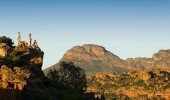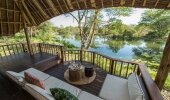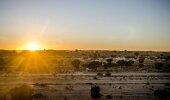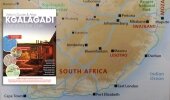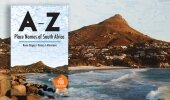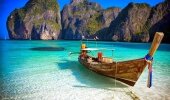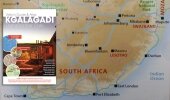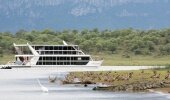Words & Photos: Xen & Adri Ludick
It is always good to start a long journey with one or two rest days. And that is exactly what we decided to do before embarking on our 7,200km trip through central Kalahari, up to the Okavango, through Kaudom, past Etosha to Ruacana and Epupa and then on to Purros, Palmwag, central Namibia, the KAA section of the Kgalagadi in Botswana and finally back home.
Photo credit: Xen & Adri Ludick
Our first two nights would be spent at the popular Khutse Game Reserve, so we left Midrand and headed towards Zeerust, then on to Gabarone, crossing the border at the Tlokweng Border Post. From here we travelled to Molepolele and Letlhkeng. Trying an alternative route, we proceeded through the Pioneer Gate Skilpadshek Border Post near Lobatse, past Khanye to Moshupa, Thamaga, Molepolele and finally to Letlhkeng - where fuel is available. This route is about 20km longer, but it is a very scenic one and you don’t have to contend with the awful Gabarone traffic and road works, thus saving approximately an hour in travelling time.
Although Botswana is a relatively flat country, you can still find fragments of ancient rocks; possibly the oldest rock in the world at more than 3.5 billion years old. Leaving Molepolele, we proceed to Letlhakeng on tar, but thereafter it was a good, easy to travel gravel road. Letlhakeng is 100km from the Khutse entrance gate and the last place to fill up. It’s also where I always enjoy indulging in some retail therapy at the true African stores. The next little village is Khudumelapye, through Salajwe, and finally the entrance and anticipation of spotting a myriad of game the reserve has to offer.
The area had received good rains just prior to our arrival, so we were in for a few detours through the veld to miss literally dams of water. On a previous trip when we had travelled on this road, Xen had experienced problems controlling the car on the slippery mud surface. But on our last trip, work had been done to level the road so we were confident that travelling this road in future would be easier, even in the rainy season; and it was. The town of Kungwane is off the main road and a worthwhile detour before travelling the last 43km, which is very sandy, to the reserve.
As we arrived at the gate it was hard to contain our excitement at having finally arrived and what lay in store for us. We enquired if the campsite at Moreswa 2 was available as it has such a beautiful view over the pan and would be relatively quiet. It was available, however on our last evening we had to share it with a father and his son, who had originally booked the site. The lesson learnt from this double booking was: ‘Don’t trust the office at the gate – stick to your booking’, as people arrive from Central Kalahari and don’t go through Khutse Gate or arrive late at the campsite. For two glorious days we relaxed in hammocks, read, enjoyed nature and prepared ourselves for the next few weeks of travelling.
‘Shloep, shloep’ sounds woke us the next morning and we realised that it was the gemsbok walking over the pan, which was covered in water from the recent rains. Between the waterhole and solar system is an area that is frequented by a leopard, and we were so privileged to see it again. We also saw a pack of 14 wild dogs. Whilst sitting at the waterhole watching the giraffes and gemsbok coming to drink water, the pack of wild dogs appeared some 10m from us and moved towards the waterhole. The next minute the wild dogs started chasing the giraffes and gemsbok, positioned on opposite sides of the waterhole, so that they had it for themselves. That evening we counted seven gemsbok, but by the next morning we only saw six. Having heard the wild dogs barking during the night, we assumed that the missing gemsbok had met its fate.
From Moreswe we drove north past the Molose waterhole to Khwankhwe Pan. On the way we saw a hare running in our direction, but when it spotted us it applied its super efficient ABS brakes and covered in a cloud of dust, it darted into the safety of the bush. We burst out laughing and relived this comical experience for many kilometres. We also saw a beautiful spotted eagle owl and reminisced on the giant eagle owl we had been so lucky to see on a previous visit.
Every time we travel from Khutse to Central I promise myself never to do this route again. The route is approximately 250km long, has deep sand and is not an enjoyable drive. Besides Khori bustards and some other birds, we have never seen any other animals. When the printed map says ‘deep sand’ it really means that the sand is thick, especially during the midday heat. Old Faithful handles the road very well and we have even helped quite a few stranded people. However, on one occasion we rented a vehicle so we can fully understand how it feels to get stuck and have to dig out a vehicle in the middle of the day; it’s no fun! Along this route we also saw four burnt out vehicles that were not fortunate enough to complete their journey. On another occasion we came across a vehicle that had a branch lodged between the rear tyre and the shock absorber. The minute we saw smoke we pulled over and removed the branch and thankfully not much damage was caused to the tyre. Another valuable lesson learnt was to regularly check your rearview mirror and should you suspect a problem, pull over and investigate.
Photo credit: Xen & Adri Ludick
The Xaxa campsite is 60km from Xade and an oasis with a beautiful natural waterhole. That morning we woke before sunrise and heard lions roaring in the direction of the waterhole. We immediately packed up our belongings and within 250m of our campsite we saw the biggest Kalahari lion and lioness we’ve ever seen. They were in a teasing and playful mood, so we watched them for about an hour, enjoying their antics. Xaxa is known for its bullfrogs in the summer and the campfire stories were filled with tales about how aggressive they are and that they are also known to bite feet!
Upon arriving at Xade we realised that we were running low on fuel and decided to drive to Ghanzi, which is about 187km away, to fill up. The first 68km was on a very poor road, but the rest was a good gravel road. On our way back we were delighted to see a badger on the side of the road, a none-to-common sighting. It was late afternoon when we drove the final 72km from Xade to Piper Pan, which took us about two hours. The sunset over the Kalahari flats is something you can’t describe in words or capture by photo. In the last of the disappearing light we watched a goshawk carrying a little brown bird that it had caught from one tree to another, and we marvelled once again at the wonder of nature and how fortunate we were to be here, to be one with it.
The next morning we went for a game drive around Piper Pan, which is very picturesque and attracts an array of animals. Despite it looking dry to us, we got stuck in black cotton soil. In this flat area, with no people in sight for days, we tried all possible recovery techniques to get out, but the more we tried the deeper we got stuck. Xen eventually found a bush that we could use to winch the car out and it’s amazing how the fear of snakes or spiders disappear when the adrenaline kicks in. We fearlessly crept through and over the dense bushes to set up the branch protectors and winch cable. When we finally pulled Old Faithful out, the wheels looked like a pottery wheel.
Happy to be in motion again, we travelled to Deception Valley via the San and Tau Pans and spotted a leopard walking over the pan in the middle of the day. For me, Tau Pan is the most spectacular pan of all and full of animals. A few years ago a lodge was built close to this pan, so it’s busier now with more vehicles travelling around it.
Whilst heading to Kori 4 campsite on the Tau / Deception Road, we spotted yet another leopard walking in the road. We also saw a warthog with uncharacteristically long hair, which we decided to call the ‘alternative flower child’.
In Central you always see big groups of gemsbok, red hartebeest, giraffe, eland and many more. As we arrived at Kori 4 in Deception Valley, where we would spend the next two days, we were welcomed by a peaceful group of gemsbok grazing around our campsite. The evenings were spent enjoying the barking geckos and sunset, always an indescribable experience. On the morning we left, we were bid farewell by a leopard not 100m away from campsite. Always remember that when travelling in Central you need to be self sufficient and carry enough water and petrol with you.
In the next issue of DO IT NOW we head north to the beauty of the Okavango swamps.
Recommended campsites at Khutse Game Reserve and Central Kalahari Game Reserve:
Central Kalahari has campsites at Deception, of which six campsites are not close to the pan. Kori is on the pan and has four campsites that we recommend as they are known for leopard sightings, which we can vouch for. Lekhubu has one secluded campsite that is in the middle of the bush. Letiahau has one campsite and Piper Pan has two, all are very nice although quite a distance away from Sunday Pan, which has three campsites and we recommend No 1 because of its great view over the pan. Passarge Valley has three campsites and here we recommend No 2 as it is also lovely and has a fabulous view over the pan.
The 10 Khutse campsites are situated close to the Khutse Pan. They are too close to each other and we don’t enjoy staying there. However, if we didn’t have an option we would choose No 1, 8 or 10. Each campsite has a centrally-placed pit latrine. Mahurushele Pan has two campsites near the edge of the pan and Sekushuwe Pan has one campsite under a large camel thorn acacia. Khankhe Pan has four campsites on a dune overlooking the pan and we recommend No 1 and 4. Although there are not many animals to be found here, it has its own beauty and peacefulness. Molose Waterhole has four campsites and you have to drive to the waterhole, but this is where we had lions walking through our campsite at Molose 1. Moreswa has four campsites and we recommend Moreswa 2 for its gorgeous view over the pan.
